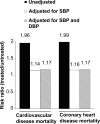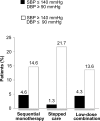The evolution of systolic blood pressure as a strong predictor of cardiovascular risk and the effectiveness of fixed-dose ARB/CCB combinations in lowering levels of this preferential target
- PMID: 19337545
- PMCID: PMC2663439
- DOI: 10.2147/vhrm.s4073
The evolution of systolic blood pressure as a strong predictor of cardiovascular risk and the effectiveness of fixed-dose ARB/CCB combinations in lowering levels of this preferential target
Abstract
Elevated blood pressure is an important cardiovascular risk factor. Although targets for both diastolic blood pressure (DBP) and systolic blood pressure (SBP) are defined by current guidelines, DBP has historically taken precedence in hypertension management. However, there is strong evidence that SBP is superior to DBP as a predictor of cardiovascular events. Moreover, achieving control of SBP is assuming greater importance amongst an aging population. In spite of the growing recognition of the importance of SBP in reducing cardiovascular risk and the emphasis by current guidelines on SBP control, a substantial proportion of patients still fail to achieve SBP targets, and SBP control is achieved much less frequently than DBP control. Thus, new approaches to the management of hypertension are required in order to control SBP and minimize cardiovascular risk. Fixed-dose combination (FDC) therapy is an approach that offers the advantages of multiple drug administration and a reduction in regimen complexity that favors compliance. We have reviewed the latest evidence demonstrating the efficacy in targeting SBP of the most recent FDC products; combinations of the calcium channel blocker (CCB), amlodipine, with angiotensin receptor blockers (ARBs), valsartan or olmesartan. In addition, results from studies with new classes of agent are outlined.
Keywords: angiotensin receptor blocker; calcium channel blocker; combination therapy; hypertension; systolic blood pressure.
Figures





Similar articles
-
Efficacy of fixed-dose combination therapy in the treatment of patients with hypertension: focus on amlodipine/valsartan.Clin Drug Investig. 2010;30(9):625-41. doi: 10.2165/11538440-000000000-00000. Clin Drug Investig. 2010. PMID: 20626210 Review.
-
Rationale for triple fixed-dose combination therapy with an angiotensin II receptor blocker, a calcium channel blocker, and a thiazide diuretic.Vasc Health Risk Manag. 2012;8:371-80. doi: 10.2147/VHRM.S28359. Epub 2012 Jun 11. Vasc Health Risk Manag. 2012. PMID: 22745561 Free PMC article. Review.
-
S-amlodipine plus chlorthalidone vs. S-amlodipine plus telmisartan in hypertensive patients unresponsive to amlodipine monotherapy: study protocol for a randomized controlled trial.Trials. 2018 Jun 20;19(1):324. doi: 10.1186/s13063-018-2636-1. Trials. 2018. PMID: 29925421 Free PMC article.
-
Rationale, design and patient baseline characteristics of OlmeSartan and calcium antagonists randomized (OSCAR) study: a study comparing the incidence of cardiovascular events between high-dose angiotensin II receptor blocker (ARB) monotherapy and combination therapy of ARB with calcium channel blocker in Japanese elderly high-risk hypertensive patients (ClinicalTrials. gov no. NCT00134160).Hypertens Res. 2009 Jul;32(7):575-80. doi: 10.1038/hr.2009.60. Epub 2009 May 15. Hypertens Res. 2009. PMID: 19444280 Clinical Trial.
-
Efficacy and Safety Assessment of Hypertension Management with Coveram (Perindopril/Amlodipine Fixed Combination) in Patients with Previous Angiotensin Receptor Blocker (ARB) Treatment: Arabian Gulf STRONG Study.Curr Vasc Pharmacol. 2016;14(6):570-575. doi: 10.2174/1570161114666160722112110. Curr Vasc Pharmacol. 2016. PMID: 27456109
Cited by
-
Blood pressure in frail older adults: associations with cardiovascular outcomes and all-cause mortality.Age Ageing. 2020 Aug 24;49(5):807-813. doi: 10.1093/ageing/afaa028. Age Ageing. 2020. PMID: 32133525 Free PMC article.
-
Multiple Points Change in the Association of Blood Pressure Subtypes with Anthropometric Indices of Adiposity among Children in a Rural Population.Children (Basel). 2020 Apr 2;7(4):28. doi: 10.3390/children7040028. Children (Basel). 2020. PMID: 32252482 Free PMC article.
-
Heritabilities, proportions of heritabilities explained by GWAS findings, and implications of cross-phenotype effects on PR interval.Hum Genet. 2015 Nov;134(11-12):1211-9. doi: 10.1007/s00439-015-1595-9. Epub 2015 Sep 18. Hum Genet. 2015. PMID: 26385552 Free PMC article.
-
Cardiac Baroreflex, HRV, and Statistics: An Interdisciplinary Approach in Hypertension.Front Physiol. 2019 Apr 30;10:478. doi: 10.3389/fphys.2019.00478. eCollection 2019. Front Physiol. 2019. PMID: 31114505 Free PMC article.
-
Renoprotective Effect of the Combination of Renin-angiotensin System Inhibitor and Calcium Channel Blocker in Patients with Hypertension and Chronic Kidney Disease.Chin Med J (Engl). 2016 Mar 5;129(5):562-9. doi: 10.4103/0366-6999.176987. Chin Med J (Engl). 2016. PMID: 26904991 Free PMC article.
References
-
- Bangalore S, Kamalakkannan G, Parkar S, et al. Fixed-dose combinations improve medication compliance: a meta-analysis. Am J Med. 2007;120:713–9. - PubMed
-
- Benetos A, Thomas F, Bean KE, et al. Why cardiovascular mortality is higher in treated hypertensives versus subjects of the same age, in the general population. J Hypertens. 2003;21:1635–40. - PubMed
-
- Benetos A, Thomas F, Safar ME, et al. Should diastolic and systolic blood pressure be considered for cardiovascular risk evaluation: a study in middle-aged men and women. J Am Coll Cardiol. 2000;37:163–8. - PubMed
-
- Black HR, Elliott WJ, Neaton JD, et al. Baseline characteristics and early blood pressure control in the CONVINCE Trial. Hypertension. 2001;37:12–18. - PubMed
Publication types
MeSH terms
Substances
LinkOut - more resources
Full Text Sources
Medical

